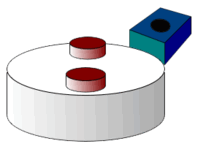
Photo from wikipedia
We present a series of model experiments where an electrically non-conductive solid sphere moves inside a vertical column of liquid alloy GaInSn. The experimental setup consists of the liquid metal… Click to show full abstract
We present a series of model experiments where an electrically non-conductive solid sphere moves inside a vertical column of liquid alloy GaInSn. The experimental setup consists of the liquid metal container, the sphere driving system and the permanent magnet with the attached force sensor. The sphere moves at a controllable constant velocity $$U_0$$ and follows a straight route, which in turn generates a liquid metal flow around the sphere. This flow interacts with the localized magnetic field of the permanent magnet, and thus a weak reaction force on the magnet is generated. The force sensor attached on the magnet has a resolution of the order $$10^{-6}~\text {N}$$ . Upon elimination of high frequency noise, reproducible time-dependent signals for the forces on the magnet are obtained in the experiments for several Reynolds numbers Re between 160 and 2000. The force component $$F_z$$ on the magnet parallel to the direction of particle motion exhibits a typical two-peak structure with different peak heights, whereas the transverse force component $$F_x$$ resembles an antisymmetric pulse. The results demonstrate that the force sensor can detect the presence of a moving particle in a quiescent conducting liquid. They also show that the structure of the $$F_x$$ signal can be reproduced with less variation and is less sensitive to the Reynolds number than the $$F_z$$ signal. Moreover, the structure and magnitude of time-dependent Lorentz force signals can be reasonably predicted by a numerical model.
Journal Title: Experiments in Fluids
Year Published: 2021
Link to full text (if available)
Share on Social Media: Sign Up to like & get
recommendations!